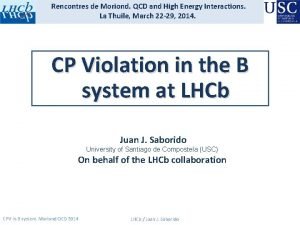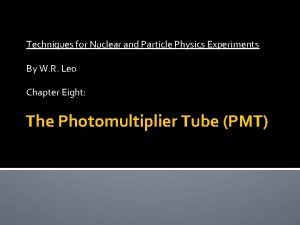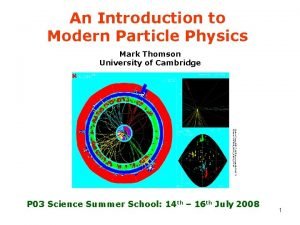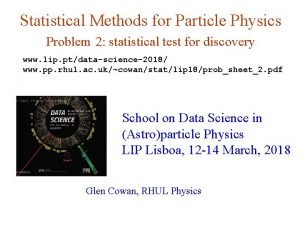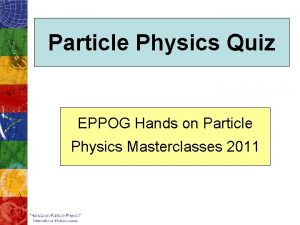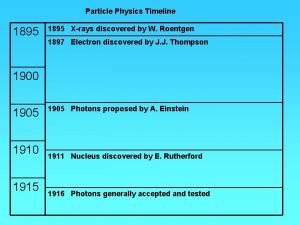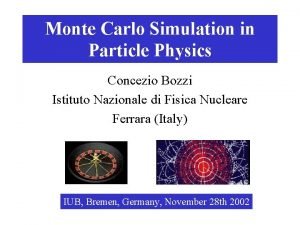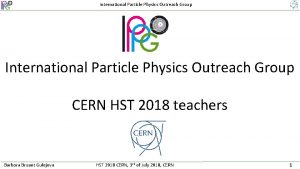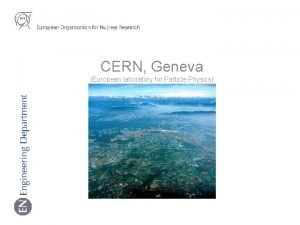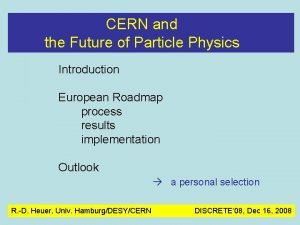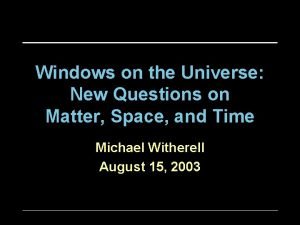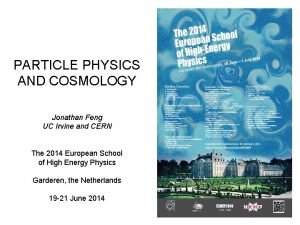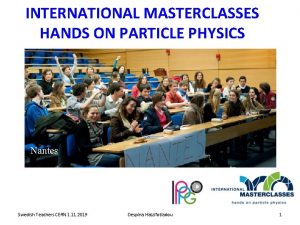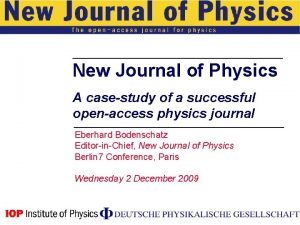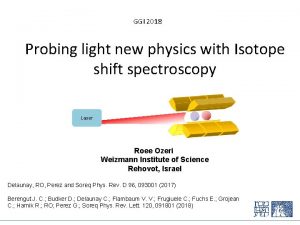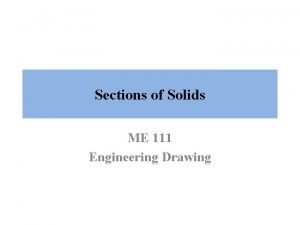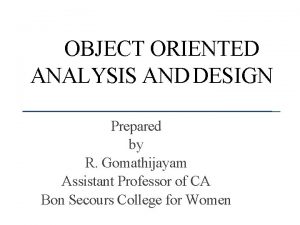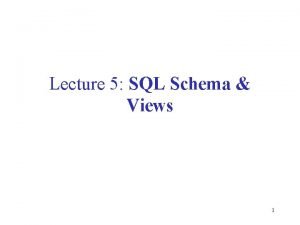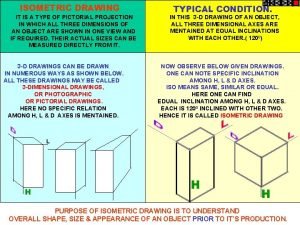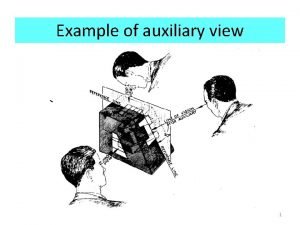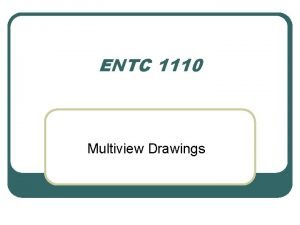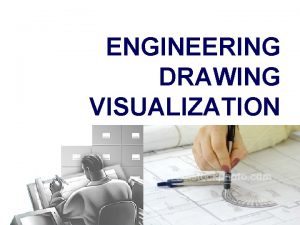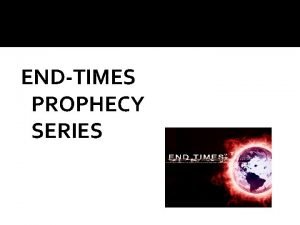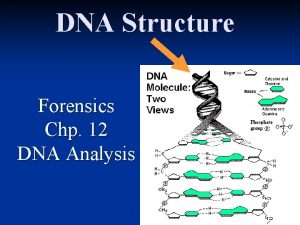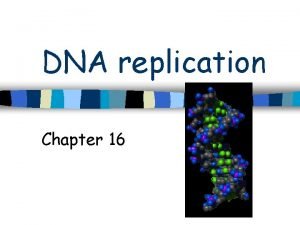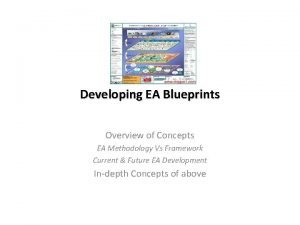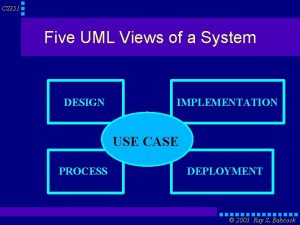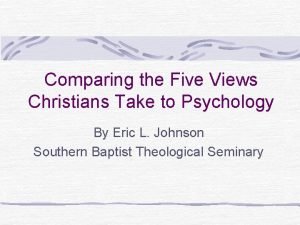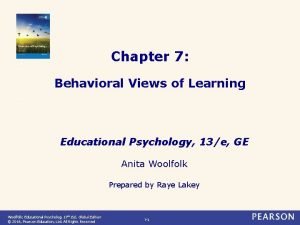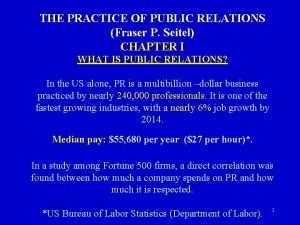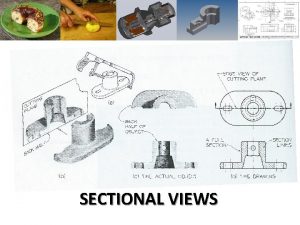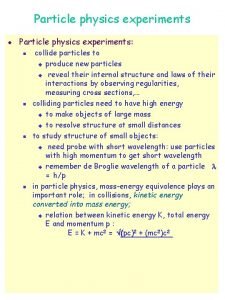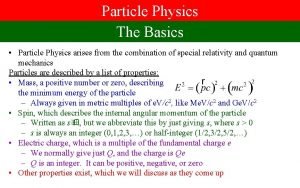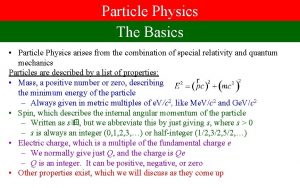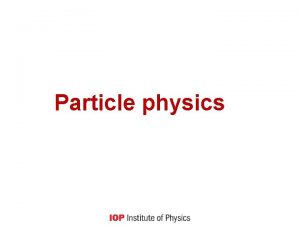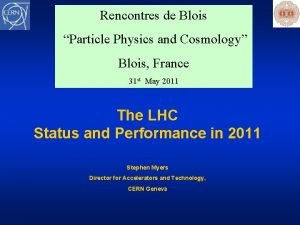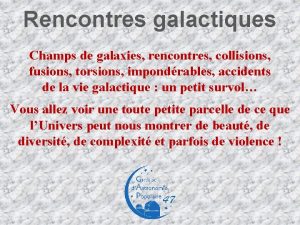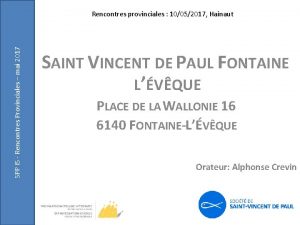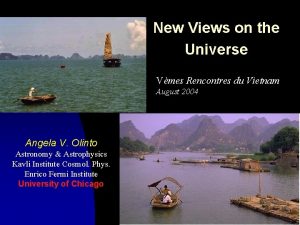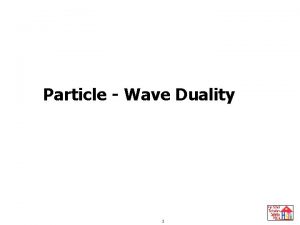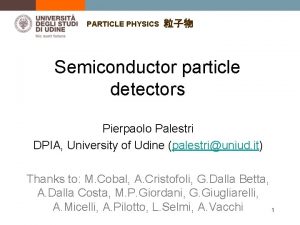New Views in Particle Physics Vemes Rencontres du









































































- Slides: 73

New Views in Particle Physics Vemes Rencontres du Vietnam Conference Summary Stanley Wojcicki Stanford University Hanoi, Vietnam August 11, 2004 1

2 The Main Themes at the Meeting • • • Past and Future of Particle Physics CP Violation Electroweak Physics Neutrino Physics Heavy Flavor Physics QCD New Facilities Physics in Vietnam Astrophysics/Cosmology Connection

3 Plan of This Talk • Cannot possibly cover all the material that was presented • Will focus on few topics that represent the main activities in the field today • Because of time limitations had to exclude a number of important topics • Gave short shrift to theory, technology, astrophysics • Hopefully, the talk will be on the level understandable and of interest to both particle and astrophysics communities • Start with historical perspective, end with a look at the future

4 Particle Physics - The Past • Particle Physics was born a little over 60 years ago, a child of: – Cosmic Ray Physics (phenomena) – Nuclear Physics (methodology) • Its growth was aided by World War II related developments: – Acceptance of big science – Respect for physics as a “useful” science – Cold war • Its remarkable evolution was a result of successful interplay of: – Theory – Experiment – Technology (accelerators and detectors)

5 How Discoveries Happen? • Theory motivated (predicted): – positron, parity violation, neutrino, charm quark, W-, gluons, neutral currents • Unexpected experimental: – muon, strange particles, CP violation, third generation, neutrino masses, dark energy • Technology enabled: – antiproton, two neutrinos, nucleon substructure, W and Z bosons, top quark

6 Then and Now The first “Barkas and Rosenfeld wallet card ” from 1957, the forerunner of the current PDG summary. The latest, 2002 edition of PDG Review of Particle Properties, contains 974 pages.

7 Elementary Particles in 1957

8 Our “Playground” • • Quarks Leptons Force Carriers “New” Phenomena – Via quantum loops – Through direct observations Will organize talk around these points

9 The Quark Sector • The quark mass states and flavor states are different • The are connected by a unitary transformation, VCKM • The sector can be characterized by 10 measurable parameters, 6 masses, 3 angles, and 1 phase

10 Quark Masses • Quark masses are very hierarchical • The knowledge of heavy quark masses is needed to extract CKM matrix elements with precision and to calculate loop corrections • The top quark mass is especially important: – it allows one to set limit on Higgs mass – its knowledge is needed for precision tests of EW theory • Top quark decays before it hadronizes • Its many decay modes call for several different analyses

11 Top mass - an example Multivariate Template Method, 33 Lepton+Jets Events with SVX b-tag Combined D 0 and CDF measurement from Run 1: mtop = 178. 0+-4. 3 Ge. V Run 2 goal is uncertainty of 1% (1. 5 - 2. 0 Ge. V)

12 CKM Matrix • Consider first absolute values of VCKM elements • Can be determined from inclusive and exclusive decay rates and loop diagrams • The matrix is almost diagonal

13 CKM Matrix (ctd) • For only 3 generations, CKM matrix has to be unitary • Unitarity is satisfied but not a stringent test because of diagonal nature of the matrix • There was a small deviation from unitarity (row 1) • Recent measurements move Vus upward, giving a better agreement with unitarity PDG: 0. 2196 (15) Unitarity: 0. 2265 (23) (8, 21) Hyperons: 0. 2250 (27) K+->p 0 e+n: 0. 2272 (22, 7, 18) K 0 L->pln: 0. 2252

14 Vub - small element • Information comes from charmless B decays • Small branching ratios is one experimental problem • Difference between B’s and b quarks is another – Lattice gauge calculations – Better new data (CLEO) – Inclusive/exclusive difference (3. 23 +-. 62) x 10 -3 (4. 57 +-. 61) x 10 -3

15 Vtb - Better Direct Measurement? • Today our information on Vtb comes from dominance of t->bl+nl over those without b and is quite poor = 0. 94+0. 31 -0. 24 • Single top production proportional to |Vtb|2 • Full Run 2 Tevatron data might make observation possible

16 CKM Phase - CP Violation • CKM matrix unitarity implies that sum of products over elements of row and column must vanish equivalent to a triangle • 1 st and 3 rd rows - all sides O(l 3) -> large angles V*tb. Vud

17 CKM Triangle (ctd) • Closing of a triangle is an important check of validity of Standard Model • Different measurements place different constraints on the triangle with different levels of accuracy: – First class, uncertainties in 2 nd order (B->J/ K 0 s) – Second class, uncertainties ~10% but constrained (e. K) – Third class, accuracies are model dependent (B->Kp)

18 CP violation - History • 1964 - CP discovered through observation of decay K 0 L ->p+p- ; measurement of e • 1974 - Kobayashi-Maskawa paper, three generations needed for CP violation in SM • ~2000 - Determination that e’is not zero, ie existence of direct CP violation • ~2000 - initiation of study of CP violation in B decays with asymmetric B factories at SLAC & KEK • ~2004 - very strong constraint on SM CKM phase as responsible for CP violation observed

19 Different CP violation mechanisms • CP violation occurs when different amplitudes, with a relative phase, contribute to the same final state • Unlike the K system, the B system has many channels with potential CP violation with varying level of quality of theoretical predictability. • The B->J/ K 0 S is the “golden”channel, A a sin(2 b)sin(Dmt)

20 The Richness of B Physics f. Ks, ’Ks, Ksp 0… The ability to investigate all these channels has been made possible by the excellent performance of the 2 colliders (285 and 244 fb-1 accumulated so far)

21 CP violation in the B system • One can observe time dependent asymmetries by tagging the other B • The asymmetries occur on a scale of fraction of a mm • The golden B decay channel, B->J/ K, gives sin 2 b=0. 736+-. 049

22 Global Unitary Triangle Fit Excellent agreement between different measurements, both CP violating and CP conserving More measurements to come in the future

23 Other CP Results • Other measurements in the B and K system consistent with the Standard Model • Only potential anomaly in f. KS final state: – BELLE -> A = -0. 96+-. 50 – Ba. Bar -> A = +. 47+-. 34 – Expect similar A as in J/ K 0 S decay (~0. 74) • Direct CP violation; recent evidence from the rates for B->Kp decay channels: – Ba. Bar: A = 0. 133 +-. 030 – BELLE: A = 0. 088 +-. 035 , the B 0 ->K+p- is higher

24 CKM Matrix Summary • The parameters are now measured quite well • The overall picture is consistent with the Standard Model expectations • Regarding CP: “We left the era of hoping for New Physics alternatives to CKM; we are in the era of seeking corrections from NP to CKM” (Y. Nir) • Now is “the time for theory of quark masses and CKM elements” (J. Rosner)

25 Leptons (mainly neutrinos) • The last decade has seen a revolution in neutrino physics • Contrary to Standard Model picture, there is good evidence that neutrinos have masses and do change flavor • Thus they have a great similarity to quarks: mass states and flavor states are related by a unitary matrix. • CKM matrix -> PMNS matrix

26 Neutrino Oscillations Fraction of I in a Fraction of b in 1 Change in phase Uai*, Ubi, mi 2 are constants of nature; L, E experimental parameters

27 Dm 2 and L/E scales • To obtain maximum oscillations, we want phase, ie. (L/E )Dm 2, to be around p/2: • For atmospheric Dm 2 (2 -3 x 10 -3 e. V 2) – Atmospheric - E~1 Ge. V, L~10 -104 km – Accelerator - E~Ge. V’s -> L~few hundred km – Reactor - E~Me. V’s -> L ~km, • For solar Dm 2 (6 -8 x 10 -5 e. V 2) – Reactor - E~Me. V’s -> L~100 km – Sun - E~Me. V’s but mass eigenstate so L~108 km OK • LSND region - Dm 2 (0. 1 - 1 e. V 2) – Ignore in this summary; being addressed by Mini. Boo. NE

28 Atmospheric neutrinos • Primary cosmic ray protons interact in the atmosphere to give hadronic showers • Large fraction of resulting p’s and m’s will decay giving nm’s and ne’s • At medium and high energies nm flux will be up/down symmetric • But upward going nm’s have longer pathlength

29 Super. K Results on nm Rates No oscillations Oscillations

30 K 2 K Experiment using Super. K and a nm beam from K 2 K with L=250 km (normalized by area) No Oscillation (KS prob: 0. 11%) Best Fit (KS prob: 52%) 108 events observed 151+-11 expected (no osc) Best fit parameters: Maximum mixing Dm 2 = 2. 73 x 10 -3

31 K 2 K/Super. K Comparison

32 SNO Basic Idea • Use deuterons (heavy water) as target • This allows three separate measurements: – ne + d -> e- + p +p gives Fcc = Fe – nx + d -> nx + p + n gives Fnc = Fe + (Fm + Ft) – nx + e- -> nx + e- gives Fes = Fe +. 154(Fm + Ft) • Each measurement gives a line in the space defined by Fe and (Fm + Ft)

33 SNO Results Summary BP 04 n. SSM = 5. 8 (13)

34 Kam. LAND Experiment • A 1 kt underground liquid scintillator detector in Japan detecting ne’s from many reactors about 180 km away • In 766. 3 ton-yr exposure, there are: – 258 observed events – 365 +- 24 expected if no oscillations – 7. 5 +- 1. 3 background events • Observed energy spectrum is distorted

35 Combined SNO/Kam. LAND Fit

36 Summary of Oscillation Results The Unknowns: a) Value of q 13 b) Value of d (CP) c) Mass hierarchy d) Is q 23 = 45 o ? e) Nature of LSND f) anomaly g) Mass Differences: Dm 12 ~ 8 me. V Dm 13 ~ 50 me. V

37 Nature of neutrinos • Are neutrinos their own antiparticles, ie Majorana n’s? • No reason why not. No distinguishing quantum number if no lepton number conservation • If so, neutrinoless double beta decay possible • Probably only practical way to resolve the question

38 Experimental Status • • Today a questionable claim to a signal in Germanium by a subset of Moscow Heidelberg group; meff=. 39 e. V Want to reach sensitivity of at least 20 me. V That would allow observable signal if masses degenerate (ie lowest mass >> 20 me. V) or if inverted hierarchy This will require: – – About 1 ton of right isotope Good resolution (2 b 2 n suppression) Low external background Better knowledge of matrix elements

39 Summary of Double b Possibilities

40 Lepton number violation in l+ • Currently no lepton flavor violation observed in charged leptons • Best limit in m-->e- capture: 6 x 10 -13 • There are good prospects for improving sensitivity in the future to 10 -16 - 10 -18 • That would give sensitivity to new physics: supersymmetry, heavy neutrinos, leptoquarks… • Flavor violation in n’s gives negligible effect

41 Forces and Force Carriers • The topics of interest in electroweak and strong forces are quite different • In the former we want to test SM predictions and/or make precise measurements • In the latter the interesting issues are either calculational or involve new phenomena

42 Direct W Mass Measurements • • Tevatron, leptonic decay - 80. 452 (059) LEP 2 - cross section evolution - 80. 411 (044) LEP 2 - direct reconstruction - 80. 420 (107) Good agreement DELPHI enqq

43 Triple Gauge Couplings • Several Born level diagrams have to be combined to calculate W+W- pair production in e+e- collisions • The correct shape and agreement of W mass with direct masurements provides validation of theory

44 Radiative corrections • In comparing results of measurements with each other (or with theory) it is essential to include one loop corrections • Thus the MW, MZ relationship will be

45 Test of one-loop corrections • We can compare direct measurements of top quark and W masses with those optained from global electroweak fit • There is good agreement • Relatively light Higgs appears to be favored

46 Potential Problems • The decade old issue of conflict between ALR from SLD and AFB(b) from LEP has not gone away • Recent checks of LEP data found no systematic problems or independent evidence for anomalous b couplings • W->t coupling is somewhat high

47 QCD Topics • • • Heavy ions; new state of matter New narrow states Parton distribution functions State of as “From quarks to particles” issues – Interpretation of CP asymmetries – Calculation of CKM matrix elements – Understanding cross sections, lifetimes

48 Why do we need to understand QCD

49 Heavy Ion Collisions • 241 mb-1 of 200 Ge. V/nucleon data accumulated at RHIC at BNL • Unprecedented energy density in collision, many times the nuclear density • Allows one to search for and study a new state of matter - Quark Gluon Plasma, predicted to occur at T~175 Me. V (1 Ge. V/fm 3) • Is there evidence for such a state - deconfined quarks and gluons, as in early universe, t < 10 -5 sec • “Little Big Bang” experiment

50 A sample of results • Energy density about 30 times nuclear density • Particle/antiparticle balance around y=0 • Transparency in collisions • Lack of low momenta • Still not enough data for J/ detailed study • Jet quenching (high p. T suppression) - gluon radiation in high color density environment (predicted by Bjorken in 1976)

51 Jet Quenching Evidence

52 Potential New Narrow States • According to the quark model, the observed states will be composed of either 2 (mesons) or 3 (baryons) quarks • That restriction limits quantum numbers of allowable states and the allowable SU(3) representations (1, 8, 10) • Observation of a state with “forbidden” quantum numbers will indicate more complex combinations (pentaquarks, quark molecules, etc)

53 Experimental Indications • Recently there has been several reports of new narrow states • There have been some confirmations but also some contradictory experimental results • The most interesting of these is a state with mass around 1540 Me. V, with quantum numbers of K+ n • Such state has been predicted in 1997 as S=1 member of an antidecuplet; it would be most likely a pentaquark Predicted state Diakonov, Petrov, Polyakov

54 Examples of Mass Distributions “Discovery” “Confirmation” g + n -> K+ K- n The Jury is still out Negative result Secondary K interactions in BELLE

55 Running of as The strong coupling constant, as will have q 2 dependence, known as running. This dependence can be obtained in a number of ways, eg by looking at gluon radiation as function of cm energy in e+e- collisions:

56 Summary of as measurements • • • LEPI - as(m. Z) = 0. 1199 LEPII - as(m. Z) = 0. 1202 R value in e+e- - as(m. Z) = 0. 1200 4 jet analysis - as(m. Z) = 0. 1170 Tau BR (hadrons/leptons) - as(m. Z) = 0. 1181 Hadronic collisions - experimental precision equally good; but large theoretical uncertainties at this time

57 Structure Functions • The range in x and q 2 greatly extended by HERA • One can make accurate gluon distribution measurements at high x at the Tevatron; currently interpretation limited by theoretical uncertainties • Knowledge of parton distribution functions important for future searches for new physics at LHC

58 Progress in understanding cross sections

59 CP violation and QCD • Relating experimental values from CP violation experiments to fundamental parameters will require better ability to calculate QCD effects • Some of the examples are e. K, e. K’, B->Kp asymmetry • Many of the CP violation effects in the B system involve interference effects with (or between) different penguin diagrams

60 Higgs Situation Current Situation 8. 5 fm-1 4. 4 fm-1 Potential Tevatron Sensitivity MHiggs < 237 Ge. V (95% CL)

61 The Road Ahead of Us • I will end by attempting to look into the future • First I want to say few words about physics possibilities • Then I want to make few general comments about some aspects of our field

62 Where are we today • A great deal of progress has been achieved over the last 60 years • The particle physics phenomena are well described by our Standard Model • Much work and very precise experiments have confirmed various features of the SM • Only neutrino physics has shown verified departures from Standard Model • We know that Standard Model is only an effective theory and deeper theory must exist • We look to the future to find the answers to what it is

Future (next 10 years) 63 Predictions are hard, especially if they are about future (Yogi Berra) • Electroweak Physics (Tevatron, LHC) – Existence of Higgs, its mass – Supersymmetry and its mass scale – Overall consistency of electroweak parameters • Neutrino Physics (Accelerator beams, reactors, nuclear physics expts) – Value of q 13 or a better limit – Resolution of LSND anomaly – Double beta decay with 100 kg detector • CP violation (B-factories, LHCb, BTe. V) – Better statistics, better calculations – Maaybe disagreements with Standard Model – K 0 L -> p 0 n n • New Phenomena (Muon and/or n factories) – mu-e capture – New surprises • Astrophysics (Ice. Cube, ANTARES, NESTOR, underground DM detectors) – Dark matter – Neutrino astronomy – High energy cosmic rays

64 Higgs at LHC

65 Other Physics Dark matter searches Optimistic SUSY models tested NOn. A and T 2 K q 13 sensitivities Double b decay sensitivity

66 Future (10 years after that) • Electroweak physics (Linear Collider, SLHC) – Detailed studies of Higgs, its couplings – Precision mass of SUSY particles – New phenomena (WLWL scattering) • New Neutrino Facilities (superbeams, n factories, beta beams) – Mass hierarchy – CP violation – New phenomena • Megaton Detector – Nucleon decay – Precision neutrino studies

67 Electroweak Physics at Linear Collider Higgs mass measurement Top mass measurement from energy scan (mt=175 Ge. V)

68 The Astrophysics Connection • The field started out looking up to the “heavens” and trying to understand its “gifts”, ie cosmic rays • We are once again looking to the heavens and now try to understand “it” from what we learn on earth • Astrophysics/cosmology/particle physics connection may well be one of the most exciting developments in the field in the last decade

69 Historical Comment • Particle Physics was in its infancy in the 1956 -1965 decade • Many key discovery were made then: parity violation, neutrino, V-A, 2 n’s, CP violation, SU(3), W • Astrophysics/cosmology are in the same phase today

70 Big Science, Long Time Scales • Over the last 50 years the field has grown very much in complexity • Single purpose experiments, tend now to give way to programmatic approach with large multipurpose detectors • One consequence of this is large collaborations: in my first publication there were 6 authors; there were 79 institutions in the most recent BABAR publication; 19 authors with last name of Zhang in last BES publication. • Another one is long time scales - in MINOS, 10 years from first collaboration meeting to the present (first accelerator n this December) • Needless to say, that presents problems for postdocs and graduate students.

71 The Quest for Higher Energies • The progress in particle physics has been made possible in the past by the availability of ever higher energies • All indications are that the progress in the future will also require new colliders with ever higher energies • LHC will open up a new, and hopefully very fruitful, domain for exploration • Further ahead, ever increasing size and hence cost of new facilities (accelerators and detector systems) will make this more and more difficult • The challenge in front of us is to make it nevertheless possible

72 Internationalization • The next big machine will have to be INTERNATIONAL in true meaning of the word • This will not be easy (look at ITER) but we must overcome the challenges if we want to maintain progress • Our record in bringing in new areas in the world into the community of particle physicists is quite good - this Conference is a good example • Somehow we have to learn from our very good record in building detectors, and extrapolate them to the accelerators • The reward will hopefully be not only progress in particle physics but also progress in mutual understanding

73 Final Words (from Judy Jackson)
 Rencontres du vietnam
Rencontres du vietnam Rencontres de moriond
Rencontres de moriond Pmt particle physics
Pmt particle physics Mark thomson particle physics
Mark thomson particle physics Particle physics
Particle physics Particle physics practice quiz
Particle physics practice quiz Particle physics timeline
Particle physics timeline Concezio bozzi
Concezio bozzi Cern particle physics
Cern particle physics European laboratory for particle physics
European laboratory for particle physics Cern particle physics
Cern particle physics Particle physics
Particle physics Form factor particle physics
Form factor particle physics International masterclasses hands on particle physics
International masterclasses hands on particle physics New particle formation
New particle formation Why does it happen
Why does it happen University physics with modern physics fifteenth edition
University physics with modern physics fifteenth edition Ib physics ia ideas
Ib physics ia ideas New journal of physics impact factor
New journal of physics impact factor Ggi new physics from the sky
Ggi new physics from the sky Hadron
Hadron Split speech
Split speech New york, new jersey, pennsylvania, and delaware
New york, new jersey, pennsylvania, and delaware Fresh oil new wine
Fresh oil new wine Orchard 14
Orchard 14 Characteristics of the articles of confederation
Characteristics of the articles of confederation New-old approach to creating new ventures
New-old approach to creating new ventures New consumer capabilities in marketing
New consumer capabilities in marketing New years old is new again
New years old is new again New classical and new keynesian macroeconomics
New classical and new keynesian macroeconomics Chapter 16 toward a new heaven and a new earth
Chapter 16 toward a new heaven and a new earth Neil thisse is a loyalist answers
Neil thisse is a loyalist answers New classical and new keynesian macroeconomics
New classical and new keynesian macroeconomics Roosevelt taft wilson venn diagram
Roosevelt taft wilson venn diagram Michael itagaki
Michael itagaki Point of views in a story
Point of views in a story Types of section in engineering drawing
Types of section in engineering drawing Sectional view examples
Sectional view examples Section views
Section views Sectional view examples
Sectional view examples Romantic views of nature
Romantic views of nature The views and opinions expressed
The views and opinions expressed What point of view is he
What point of view is he Orthogonal views of software in ooad
Orthogonal views of software in ooad Third person objective vs omniscient
Third person objective vs omniscient Partial view controller
Partial view controller Types of views in sql
Types of views in sql Historical views of mental illness psychology ocr
Historical views of mental illness psychology ocr Isometric drawing type
Isometric drawing type Isometric view of pyramid
Isometric view of pyramid Judet views pelvis positioning
Judet views pelvis positioning Humanist beliefs on euthanasia
Humanist beliefs on euthanasia Types of auxiliary views
Types of auxiliary views Third person examples
Third person examples An auxiliary vertical plane (avp) is
An auxiliary vertical plane (avp) is The six standard views
The six standard views What angle is axonometric drawing
What angle is axonometric drawing End times views charts
End times views charts Section view in engineering drawing
Section view in engineering drawing Dna molecule two views
Dna molecule two views Phosphodiester bond
Phosphodiester bond The views expressed disclaimer
The views expressed disclaimer Lindmat watch
Lindmat watch The views and opinions expressed disclaimer
The views and opinions expressed disclaimer Views expressed disclaimer
Views expressed disclaimer Ea blueprint
Ea blueprint Uml views
Uml views Psychology and christianity five views
Psychology and christianity five views The views and opinions expressed disclaimer abs-cbn
The views and opinions expressed disclaimer abs-cbn Behavioral views of learning
Behavioral views of learning Introduction of orthographic projection
Introduction of orthographic projection Hispanic cultural views on teenage pregnancy
Hispanic cultural views on teenage pregnancy What contributed to changing european views
What contributed to changing european views The practice of public relations
The practice of public relations

